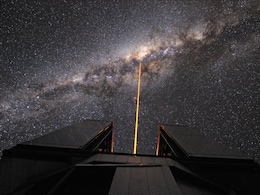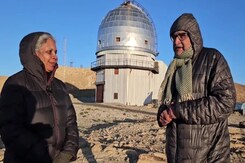Astronomy Cosmos
- All
- News
- Videos
- Web Stories
-

SpaceX Falcon 9 Successfully Deploys NASA’s SPHEREx Telescope and PUNCH Probes
- Thursday March 13, 2025
- Written by Gadgets 360 Staff
NASA’s SPHEREx and PUNCH missions have successfully launched aboard a SpaceX Falcon 9 rocket from Vandenberg Space Force Base in California. SPHEREx will map the entire celestial sky in 102 infrared colours, while PUNCH will study the transition of the sun’s corona into the solar wind. The two-year missions aim to deepen our understanding of th...
-
 www.gadgets360.com
www.gadgets360.com
-

A World-First Discovery - Twin Stars Trapped Orbiting Galactic Black Hole
- Wednesday December 18, 2024
- World News | The Conversation
At the centre of the Milky Way is a supermassive black hole called Sagittarius A*. It is roughly 27,000 light years from Earth and 23.5 million kilometres in diameter.
-
 www.ndtv.com
www.ndtv.com
-

This Alien Planet Has Astronomers Puzzled. Defies Current Understanding Of Physics
- Saturday November 23, 2024
- World News | Reuters
Astronomers have spotted orbiting around a young star a newborn planet that took only 3 million years to form - quite swift in cosmic terms - in a discovery that challenges the current understanding of the speed of planetary formation.
-
 www.ndtv.com
www.ndtv.com
-

Here's How James Webb Space Telescope Helps Us Look Back in Time
- Tuesday November 19, 2024
- Written by Gadgets 360 Staff
The James Webb Space Telescope allows astronomers to explore the universe’s history by observing light that has travelled across billions of light-years. This unique capability enables scientists to see how galaxies, stars, and other celestial bodies appeared billions of years ago, offering a glimpse into the early stages of the universe. By stud...
-
 www.gadgets360.com
www.gadgets360.com
-

3 Decades Later, First Brown Dwarf Ever Found Offers A Surprise
- Saturday October 19, 2024
- World News | Reuters
In 1995, astronomers confirmed the discovery for the first time of a brown dwarf, a body too small to be a star and too big to be a planet - sort of a celestial tweener. But it turns out that was not the full story.
-
 www.ndtv.com
www.ndtv.com
-

Look Up! A Once-In-A-Lifetime Explosion Is About To Create A 'New' Star In The Sky
- Wednesday July 10, 2024
- Science | The Conversation
Any night now, a "new star" or nova will appear in the night sky. While it wont set the sky ablaze, its a special opportunity to see a rare event thats usually difficult to predict in advance.
-
 www.ndtv.com
www.ndtv.com
-

NASA to Reportedly Launch an 'Artificial Star' Satellite to Help Astronomers Study the Cosmos
- Tuesday June 18, 2024
- Reported by Gadgets 360 Staff
NASA's groundbreaking Landolt Space Mission will revolutionize astronomy by launching an artificial star into Earth's orbit by 2029. This satellite, about the size of a loaf of bread, will enhance the precision of ground-based telescopes, providing astronomers with more accurate measurements of celestial objects. Equipped with eight lasers, the sat...
-
 www.gadgets360.com
www.gadgets360.com
-
Astronomers spot biggest structure in Universe
- Friday January 11, 2013
- World News | Agence France-Presse
Astronomers on Friday said they had observed the largest structure yet seen in the cosmos, a cluster of galaxies from the early Universe that spans an astonishing four billion light years.
-
 www.ndtv.com
www.ndtv.com
-

SpaceX Falcon 9 Successfully Deploys NASA’s SPHEREx Telescope and PUNCH Probes
- Thursday March 13, 2025
- Written by Gadgets 360 Staff
NASA’s SPHEREx and PUNCH missions have successfully launched aboard a SpaceX Falcon 9 rocket from Vandenberg Space Force Base in California. SPHEREx will map the entire celestial sky in 102 infrared colours, while PUNCH will study the transition of the sun’s corona into the solar wind. The two-year missions aim to deepen our understanding of th...
-
 www.gadgets360.com
www.gadgets360.com
-

A World-First Discovery - Twin Stars Trapped Orbiting Galactic Black Hole
- Wednesday December 18, 2024
- World News | The Conversation
At the centre of the Milky Way is a supermassive black hole called Sagittarius A*. It is roughly 27,000 light years from Earth and 23.5 million kilometres in diameter.
-
 www.ndtv.com
www.ndtv.com
-

This Alien Planet Has Astronomers Puzzled. Defies Current Understanding Of Physics
- Saturday November 23, 2024
- World News | Reuters
Astronomers have spotted orbiting around a young star a newborn planet that took only 3 million years to form - quite swift in cosmic terms - in a discovery that challenges the current understanding of the speed of planetary formation.
-
 www.ndtv.com
www.ndtv.com
-

Here's How James Webb Space Telescope Helps Us Look Back in Time
- Tuesday November 19, 2024
- Written by Gadgets 360 Staff
The James Webb Space Telescope allows astronomers to explore the universe’s history by observing light that has travelled across billions of light-years. This unique capability enables scientists to see how galaxies, stars, and other celestial bodies appeared billions of years ago, offering a glimpse into the early stages of the universe. By stud...
-
 www.gadgets360.com
www.gadgets360.com
-

3 Decades Later, First Brown Dwarf Ever Found Offers A Surprise
- Saturday October 19, 2024
- World News | Reuters
In 1995, astronomers confirmed the discovery for the first time of a brown dwarf, a body too small to be a star and too big to be a planet - sort of a celestial tweener. But it turns out that was not the full story.
-
 www.ndtv.com
www.ndtv.com
-

Look Up! A Once-In-A-Lifetime Explosion Is About To Create A 'New' Star In The Sky
- Wednesday July 10, 2024
- Science | The Conversation
Any night now, a "new star" or nova will appear in the night sky. While it wont set the sky ablaze, its a special opportunity to see a rare event thats usually difficult to predict in advance.
-
 www.ndtv.com
www.ndtv.com
-

NASA to Reportedly Launch an 'Artificial Star' Satellite to Help Astronomers Study the Cosmos
- Tuesday June 18, 2024
- Reported by Gadgets 360 Staff
NASA's groundbreaking Landolt Space Mission will revolutionize astronomy by launching an artificial star into Earth's orbit by 2029. This satellite, about the size of a loaf of bread, will enhance the precision of ground-based telescopes, providing astronomers with more accurate measurements of celestial objects. Equipped with eight lasers, the sat...
-
 www.gadgets360.com
www.gadgets360.com
-
Astronomers spot biggest structure in Universe
- Friday January 11, 2013
- World News | Agence France-Presse
Astronomers on Friday said they had observed the largest structure yet seen in the cosmos, a cluster of galaxies from the early Universe that spans an astonishing four billion light years.
-
 www.ndtv.com
www.ndtv.com











